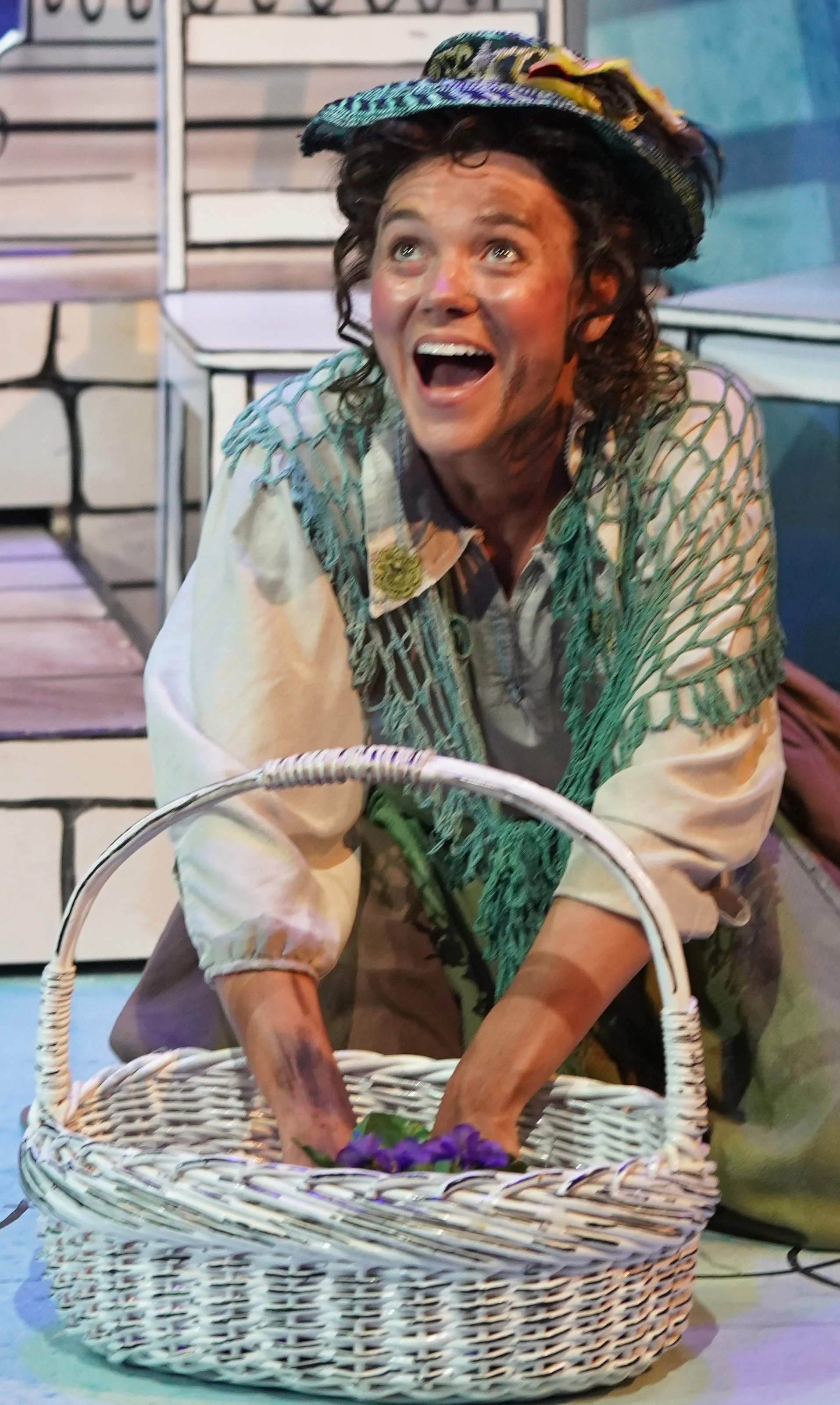Mark Evans plays Henry Higgins (left), Carson Elrod is Colonel Hugh Pickering, and Synnøve Karlsen portrays Eliza Doolittle in a new version of George Bernard Shaw’s Pygmalion, adapted and directed by David Staller.
In his current revival of Pygmalion, director David Staller does more than remount Shaw’s 1912 comedy—he alters the play’s architecture by adding a mythic framing device led by four Olympian gods who introduce and comment on the action. This addition is not found in the published script, and theatergoers expecting a traditional revival may consider it a provocation. But Staller positions it as a reclamation rather than an invention.
Eliza Doolittle begins as a Cockney flower girl who yearns to speak “like a lady” in Gingold Theatrical Group’s revival of Pygmalion. Photographs by Carol Rosegg.
In a program note, he explains that he is drawing on an idea Shaw once proposed for the 1938 Pygmalion film: a tongue-in-cheek prologue featuring Greek deities who would recount the classical myth behind the title. The film producers rejected the idea, but Staller resurrects it here as a quartet of immortals who narrate, transform into human characters, and observe the play with amused omniscience.
The myth they recount is simple: Pygmalion, a sculptor, fell in love with a statue of his own making, which the goddess Aphrodite brought to life. By invoking this tale explicitly, Staller reframes Shaw’s story of Henry Higgins and Eliza Doolittle as a modern echo of creator and creation—an echo Shaw kept mostly implicit.
To incorporate the gods’ exchange, Staller retrieved fragments of Shaw’s drafts from Sir Michael Holroyd, the playwright’s eminent biographer, in which the Irish playwright had sketched celestial banter for the film’s prologue. Staller deftly threads this material into the production, beginning with their wry salutations:
God 1: “Good evening. This simple fact may seem self-evident, but we’re gods. No, really! Once upon a time, when we gods had a little more respect, you humans loved us … watching, weaving our spells, and laughing at you.”
God 2: “We laughed at you a lot. We still do.”
God 3: “There’s so much to laugh at. We were here then, and we’ll be here when you’re gone. But for now, we’re very much here with you…”
God 4: “Tonight, we’ll revisit the story of Pygmalion.”
“[Director David Staller] is drawing on an idea Shaw once proposed for the 1938 ‘Pygmalion’ film: a tongue-in-cheek prologue featuring Greek deities.”
As the gods descend from their celestial heights, they shed their divinity to take human form—embodying the mortals whose follies they’ve been mocking. God 1 becomes Mrs. Pearce and Mrs. Higgins; God 2 transforms into Clara and Mary; God 3 slips into Freddy and Alfred Doolittle; and God 4 assumes Colonel Pickering. These shape-shifting deities are reminders that the line between divine observer and human participant is thin—and that the gods may see themselves in the people they watch.
At the center of this divine comedy stands Henry Higgins, played with brisk precision and mercurial wit by Mark Evans—a phonetics professor so obsessed with the mechanics of speech that he scarcely notices the emotions beneath it. His experiment—to transform a Cockney flower girl into a duchess by refining her accent—becomes both a scientific crusade and a moral blind spot. Opposite him, Synnøve Karlsen’s Eliza Doolittle emerges not as a subject of Higgins’s tinkering but as Shaw’s case for self-determination—a woman who learns to “speak like a lady” only to discover the limits of what such speech can buy her. Their clash plays out as a dance between creator and creation, intellect and instinct, language and identity. When Eliza presses him about her future, Higgins’s reply lays bare both his brilliance and his blindness:
Eliza: “What’s to become of me? What’s to become of me?”
Higgins: “How the devil do I know what’s to become of you? What does it matter ‘what becomes’ of you?”
Evans plays Henry Higgins, and Lizan Mitchell is God 1 in Shaw’s comedy of class, language, and self-invention.
Among the supporting cast, Carson Elrod is an ideal Pickering, his steady civility throwing Higgins’s abrasiveness into relief. Lizan Mitchell brings warmth and wry composure to Mrs. Pearce. Matt Wolpe deftly doubles as Alfred Doolittle—a philosophical guttersnipe with a gift for self-justification—and as the guileless Freddy. Teresa Avia Lim gives a layered turn as Clara, who begins by mocking Eliza and ends by imitating her.
The production’s celestial framing also informs its look. Scenic designer Lindsay Genevieve Fuori conjures a black-and-white dreamscape that is borrowed from an Al Hirschfeld line drawing—fluid, whimsical, and slyly exaggerated. The effect is both homage and invention, echoing Hirschfeld’s friendship with Staller while matching Shaw’s wit and precision.
By the end, Staller’s concept circles back on itself: the gods who toyed with mortals at the start now watch in recognition, amused and a little chastened by what they’ve seen. In this version of Pygmalion, art and life, myth and manners, creator and creation continually mirror one another. They underscore Shaw’s intention to remind his audience that transformation is never one-sided. Fittingly, this luminous revival also marks the 20th anniversary of the Gingold Theatrical Group, a company that honors Shaw’s spirit with imagination, intellect, and heart.
Pygmalion plays through Nov. 22 at Theatre Row (410 W. 42nd St.). Performance dates and times are somewhat irregular and may be viewed, along with other information, at gingoldgroup.org.
Playwright: George Bernard Shaw, adapted by David Staller
Director: David Staller
Scenic Design: Lindsay Genevieve Fuori
Lighting Design: Jamie Roderick
Costume Design: Tracy Christensen
Sound Design: Julian Evans





